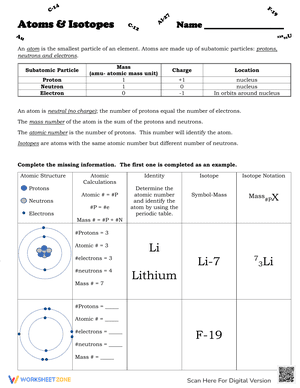The smallest unit of matter retaining all of an element's chemical properties is an atom. An atom is composed of two regions. The nucleus, which contains protons and neutrons, is in the atom’s center. The electrons are held in orbit around the nucleus by its outermost area. When we change the number of neutrons in an atom, it becomes an isotope. On the other hand, if we change the number of electrons, it becomes an ion. If you are struggling with the difference between atoms, ions and isotopes, please don’t be worried, we have provided various free atoms, isotopes, and ions worksheets for extra practice. We have included a variety of exercises and questions in these Chemistry worksheets, like determining the number of protons, neutrons, and electrons using the periodic table and information from the worksheet, determining whether an atom is an ion, isotope, or neutral atom, and so on. If you are looking for a way to re-teach and provide additional assistance when it comes to this knowledge, give our atoms, isotopes, and ions worksheets a try. We’re sure that it would be a great reinforcement activity.
Periodic TableBalancing ActConservation Of MassClassifying MatterLab SafetyChemical Bonding Ionic And CovalentAcid NamingBalancing Chemical EquationsHesss LawColligative PropertiesNet Ionic EquationLe Chatelier's PrincipleNaming Molecular CompoundsMole RatioNova Hunting The ElementsCalculating Average Atomic MassEndothermic And Exothermic ReactionNaming Ionic CompoundsStoichiometryMetals Nonmetals And MetalloidsNaming AlkanesMixtures And SolutionsMole To Grams Grams To Moles ConversionsEmpirical/Molecular Formula PracticePredicting Products Of Chemical ReactionsSolubility CurveIntermolecular ForcesProtons Neutrons And Electrons PracticeIsotope PracticeNaming Covalent CompoundsPercent CompositionTypes Of ReactionClassifying Chemical ReactionsConjugate Acid Base PairsDalton's Law Of Partial PressureGrahams LawPeriodic TrendsCounting AtomsAssigning Oxidation NumbersSingle Replacement ReactionPh And Poh CalculationsLab EquipmentLimiting ReactantNeutralization ReactionsMolar MassElectron Configuration PracticeHistory Of An AtomBohr ModelIntegrated Science CyclesPhotosynthesisOn Nitrogen CycleMacromoleculeBiogeochemical CyclesBalanced And Unbalanced ForcesKaryotypeProkaryote And Eukaryote CellsThe Carbon CycleInsulin To Carb Ratio
Allfiltered results





